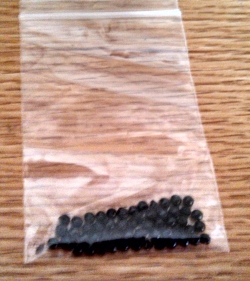OUT OF STOCK
 Here they are, by popular demand. Wild Ramp seeds. You get 50 seeds per bag for only $5.50. A great way to start your own ramp patch! We will be selling these all until all supplies are dwindled. Get them quick before we run out as supplies are limited.
Here they are, by popular demand. Wild Ramp seeds. You get 50 seeds per bag for only $5.50. A great way to start your own ramp patch! We will be selling these all until all supplies are dwindled. Get them quick before we run out as supplies are limited.
As always, there are no extra shipping fees or added costs.
Planting instructions are also included.
Ramps grow naturally under a forest canopy of beech, birch, sugar maple, and/or poplar. Other forest trees under which ramps will grow include buckeye, linden (basswood), hickory, and oak. A forested area with any of these trees present provides an ideal location for planting a ramp crop. Areas that host trillium, toothwort, nettle, black cohosh, ginseng, bloodroot, trout lily, bellwort, and mayapple should be suitable for growing ramps. If there is not a wooded area available to grow ramps, a shade structure can be erected over the planting site.
Choose a well-drained site with rich, moist soil high in organic matter. Soil moisture appears to be an important environmental variable influencing seed germination, seedling emergence rate, survival, and growth rate of the plant. Thus, adequate moisture must be maintained throughout all seasons, not just the active growing season.
Keep in mind that the growth period for ramps is limited to only a few weeks in the spring, during which time the plant is dependent on having adequate light, moisture, and nutrients for survival.
Ramps, Allium tricoccum or Allium tricoccum, var. burdickii, also known as wild leeks, are native to the eastern North American mountains. They can be found growing in patches in rich, moist, deciduous forests and bottoms from as far north as Canada, west to Missouri and Minnesota, and south to North Carolina and Tennessee. In early spring, ramps send up smooth, broad, lily-of-the-valley-like leaves that disappear by summer before the white flowers appear. The bulbs have the pleasant taste of sweet spring onions with a strong garlic-like aroma.
As one of the first plants to emerge in the spring, ramps were traditionally consumed as the season’s first “greens”. They were considered a tonic because they provided necessary vitamins and minerals following long winter months without any fresh vegetables. Traditions evolved around the annual gathering and preparation of this pungent plant. Throughout the mountains of the eastern U.S., including many western North Carolina counties, annual spring ramps festivals are held. These festivals have become major tourist attractions and are actively promoted by the communities in which they are held. The tremendous volume of ramps consumed at these festivals are gathered from the forests. In many areas, the annual intensive harvesting is seriously damaging the wild populations of ramps. Studies in Canada and Ohio demonstrated that ramps are very sensitive to how they are harvested. Years ago, gatherers would only take a small number of bulbs from a population. Now the demand for ramps is so great, the entire population is often harvested.
In recent years, white-table cloth restaurants have also begun serving ramps, increasing the demand for large, consistent supplies of the wild forest plant. Thus, in an effort to conserve native populations and meet rising demand, cultivation of ramps is strongly encouraged. Harvesting ramps from easily accessible, concentrated plantings would not only benefit festival participants, chefs, and consumers, but also create a new marketable product for the commercial grower. Native populations would be allowed to regenerate and multiply as ramps gain recognition and popularity among consumers.
Since almost all ramps consumed are harvested from wild populations, information on growing ramps is very limited. The practices described here are based on our experiences and those of the few existing ramp growers in West Virginia.


When do you expect to have some more ramp seeds available for purchase?
Would it be possible to get on a mailing list for seed? Thank you so much.
may I get on your email list?
Are there male and female ramps. If so are both required for ramp plants to multiply
How do I get on the list for seeds when you have them back in?
Sign up for the mailing list. Unfortunately, I didn’t have time to get any seeds this year, life got in the way.
I would like to purchase ramp seeds. Do you have them in stock? I would like to plant them late this summer
Spring.
I would be interested in both seeds and ramp bulbs
When will you have Ramp seeds again?
Unfortunately I don’t know if I’m going to have any this year. I have been working a huge amount of hours at my day job, and I haven’t had the time to get any.
I don’t think they have been flowering, just die back late spring.
They haven’t matured yet then. They can take around 7 years to reach maturity.
I have planted bulbs three years straight in the hollows of middle TN. The ramps are surviving but not multiplying. Any thoughts about forcing them to seed or divide/create new bulbs sub soil? Is there any success in planting the root ends of the bulbs of fresh ramps in propagating a new crop? thanks for your input.
Are the plants flowering at all after the leaves start to yellow?
I’m not too sure about planting the root end of the bulb and having them grow. It seems feasible, but I haven’t done it myself.
I SEE THAT YOU ARE ALREADY OUT OF RAMP SEED. WHEN DO YOU EXPECT TO HAVE MORE?
We should have more ramps seeds this fall.